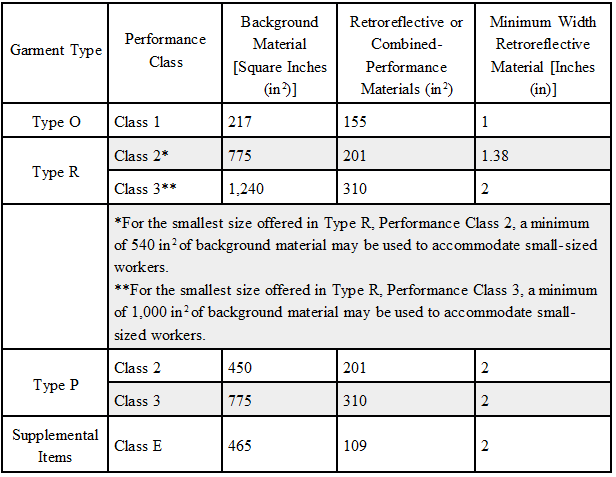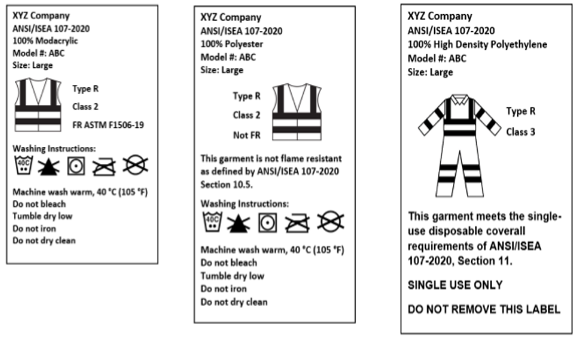High-Visibility Clothing Standard – Quick Tips
The need to be seen is critical for worker safety. This is especially true for employees who work around moving vehicles or equipment. In an effort to prevent injuries and fatalities from “struck-by” hazards, workers wearing high-visibility garments help alert vehicle operators to their presence, especially in low-light environments.
ANSI/ISEA 107-2020: American National Standard for High-Visibility Safety Apparel
The 2020 version of the American National Standards Institute (ANS) / International Safety Equipment Association (ISEA) ANSI/ISEA 107 standard is the fifth edition of the voluntary industry consensus standard.
Since its initial publication in 1999, this Standard has been the authoritative document on the design and performance requirements for high-visibility safety apparel. Performance requirements are included for color, retroreflection, physical properties and minimum areas of background, retroreflective and combined-performance materials, as well as the recommended configuration of the materials. It is codified into the Department of Transportation Federal Highway Administration (FHWA) regulations and incorporated by reference in other standards.
Because there are many working environments where garments can become easily soiled, ANSI/ISEA 107-2020 now includes specific criteria for single-use disposable coveralls. These are designed to be worn over clothing and cover a minimum of the arms, legs, and torso. They must meet the minimum material amounts and requirements imposed on all compliant high-visibility safety apparel.
ANSI/ISEA 107-2020 retains the Type-Performance Class designations of high-visibility apparel introduced in the 2015 revision. The expected use setting dictates the Type selected. The Performance Class identifies the amount of visible materials and design attributes incorporated into finished apparel. This provides a range of design options that correspond with the level of risk and the visual conspicuity needs of the wearer.
The criteria for high-visibility accessories have been removed from the 2020 standard although users are encouraged to use high-visibility accessories such as gloves, hoods and head coverings to enhance their visibility.
Types
The standard establishes three types:
- Type O (“off-road”)
- Type R (“roadway”)
- Type P (“public safety”)
Type O is defined as apparel that “provides daytime and nighttime visual conspicuity enhancement for workers in occupational environments which pose struck-by hazards from moving vehicles, equipment and machinery, but which will not include exposure to traffic on public access highway rights-of-way or roadway temporary traffic control (TTC) zones.” Examples of those who may need Type O apparel include:
- Workers retrieving shopping carts from parking areas
- Workers exposed to the hazards of warehouse equipment traffic
- Workers in oil and gas extraction, refineries and mines
Type R apparel “provides daytime and nighttime visual conspicuity enhancement for workers in occupational environments which include exposure to traffic (vehicles using the highway for purposes of travel) from public access highway rights-of-way, or roadway TTC zones or from work vehicles and construction equipment within a roadway TTC zone.” Examples of workers who may need Type R apparel include:
- Roadway construction workers
- Parking and/or toll gate personnel
- School crossing guards
- Towing operators
- Airport baggage handlers/ground crew
Type P apparel “provides daytime and nighttime visual conspicuity enhancement for emergency and incident responders and law enforcement personnel in occupational environments which include exposure to traffic (vehicles using the highway for purposes of travel) from public access highway rights-of-way, or roadway TTC zones, or from work vehicles and construction equipment within a roadway TTC zone or from equipment and vehicles within the activity area.” Type P apparel provides additional options for emergency responders and law enforcement who may experience competing hazards or require access to special equipment. Examples of workers who may need Type P apparel include:
- Law enforcement personnel
- Emergency response personnel
- Firefighting personnel
- Road closure personnel
- Accident site investigators
Performance Classes
ANSI/ISEA 107-2020 contains four performance classes:
- Performance Class 1
- Performance Class 2
- Performance Class 3
- Supplemental Class E
Each performance class has specific minimum design requirements regarding the background materials, retroreflective/combined performance materials and width of reflective materials used in the garments.
Performance Class 1 offers the minimum amount of high-visibility materials to differentiate the wearer visually from non-complex work environments and is only appropriate for off-road (Type O) environments.
Stepping up to Performance Class 2, these garments have additional amounts of high-visibility materials that allow for better definition of the human form. Performance Class 2 is considered the minimum level of protection for workers exposed to roadway rights-of-way and TTC zones, as required in the FHWA Manual on Uniform Traffic Control Devices (MUTCD).
Performance Class 3 has an even a greater minimum level of high-visibility material the apparel must contain. This class provides more visibility to the wearer in both complex backgrounds and through a full range of movement by the required placement of background, retroreflective and combined performance materials on the sleeves and pant legs (if present). A garment or vest without sleeves worn alone is NOT considered Class 3 protection.
Configurations
High-visibility safety apparel must incorporate the minimum areas of materials as shown in the table below. Both Performance Class 2 and Class 3 garments can be rated for either Type R or P environments. The distinction between a Type R or P rating lies under the required minimum levels for background material.

Supplemental Class E is comprised of high-visibility garments such as pants, bib overalls, shorts and gaiters. These items do not qualify as meeting the requirements of the standard when worn alone, but when a Class E item is worn with a Performance Class 2 or Class 3 garment, the overall classification of the ensemble is Performance Class 3.
Marking
Each piece of apparel must be marked either on the product itself or on labels attached to the product. The marking must be permanently affixed so as to be visible and legible; and durable for the appropriate number of cleaning processes. The marking must include:
- Name, trademark or other means of identification of the manufacturer or authorized representative
- Designation of the product type commercial name or code
- Size designation
- Number of specific ANSI standard, for example ANSI/ISEA 107-2020
- Statement regarding flame resistance
- Pictogram showing the type, performance class and flame resistance status
- Statement regarding single-use disposable coveralls, if applicable
The following product information must also be supplied to customers:
- Fitting – how to put on and take off, if relevant
- Warnings of misuse
- Use limitations
- Storage – how to store and maintain correctly, with maximum periods between maintenance checks
- Maintenance and cleaning – how to clean or decontaminate, with complete washing or dry-cleaning instructions
- Number of cleaning processes without impairment of its performance level
Examples of acceptable labels:

Flame Resistance
If the material meets one of the flame resistance specifications or standards identified in ANSI/ISEA 107-2020 Section 10.5, the product needs to be marked in one of the following ways:
- The garment label must include the letters FR followed by the designation of the ASTM specification used to evaluate flame resistance; or
- A separate label indicating certification to NFPA 1977 or 2112 must be attached.
If the garment does not meet any of the flame resistance standards referenced in 107-2020 Section 10.5, the garment must be marked with the following:
- This garment is not flame resistant as defined by ANSI/ISEA 107-2020 Section 10.5.
Single-Use Disposable Coveralls
The single-use disposable coveralls marking must include the following:
- This garment meets the single-use disposable coverall requirements of ANSI/ISEA 107-2020, Section 11
- SINGLE-USE ONLY
- DO NOT REMOVE THIS LABEL
Service Life
Another key area covered in ANSI/ISEA107 is service life. It notes all high-visibility items have a limited lifetime that varies with use. Variables can include type of item, type of environment and length of exposure to that environment, and the laundering method. It is the responsibility of the issuing entity, authorized on-site person, employer or wearer to periodically evaluate the minimum required visibility. Garments should be replaced or repaired when they are torn, noticeably faded, soiled, cracked, burned, heavily abraded or damaged.
The non-mandatory Appendix G addresses service life with more specificity. According to FHWA research “The useful life of garments that are worn on a daily basis is approximately six months. Garments that are not worn on a daily basis are expected to have a useful service life of up to three years.” Actual lifetimes in the field vary depending on exposure and care and could range from weeks to years.
Q: Does the ANSI/ISEA 107-2020 standard specify when to choose a Performance Class 3 garment over a Performance Class 2?
A: The standard does not call out specific tasks or situations where Performance Class 3 should be used rather than Class 2. Non-mandatory Appendix C of the standard covers suggested type and class guidelines and scenarios. While specific duties are discussed under types, performance class selection between 2 and 3 is not as clear. The appendix states that the guidelines and scenarios are intended to serve as an assessment tool only. Certain specific conditions such as “atmospherics, sight/stop distances, training, regulations, proximity and others must be taken into account in any final hazard/safety assessment. Vehicle speed should not be considered in isolation to these variables.”
Q: Can a method of identifying a Type P entity be incorporated in the high-visibility safety apparel?
A: Yes, public safety entities can be identified with the specific names and colors:
- Red: Fire Service
- Green: Emergency Medical Service (EMS)
- Blue: Law Enforcement
Sources
ANSI/ISEA 107-2020, American National Standard for High-Visibility Safety Apparel
Federal Highway Administration (FHWA) Manual on Uniform Traffic Control Devices (MUTCD)
The information contained in this article is intended for general information purposes only and is based on information available as of the initial date of publication. No representation is made that the information or references are complete or remain current. This article is not a substitute for review of current applicable government regulations, industry standards, or other standards specific to your business and/or activities and should not be construed as legal advice or opinion. Readers with specific questions should refer to the applicable standards or consult with an attorney.
Source: Grainger Know How – https://www.grainger.com/know-how